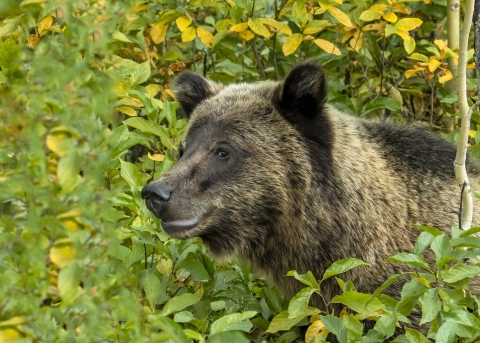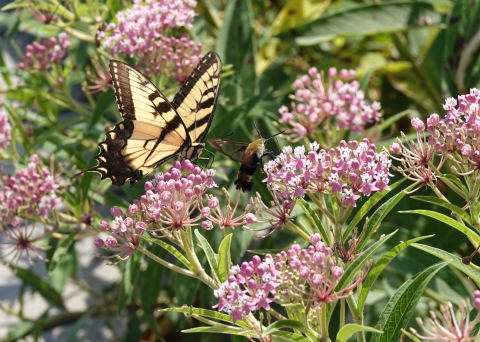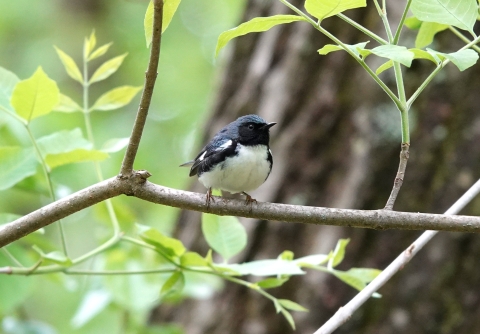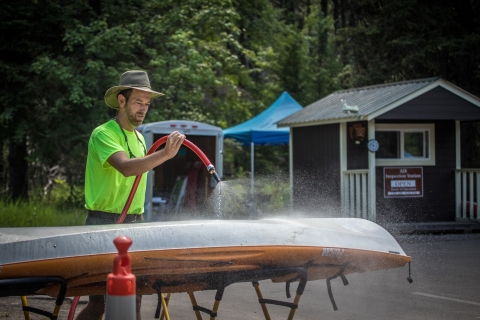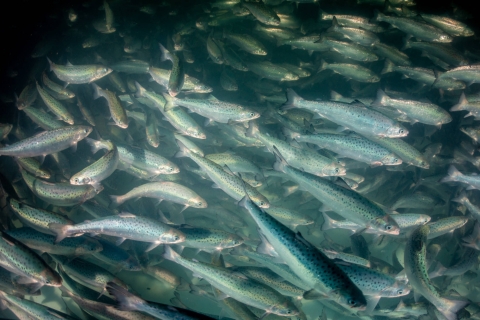We’re all smiles, and we can bear-ly contain our excitement over the 50th anniversary of the Endangered Species Act (ESA). This historic law was signed in 1973 and is considered one of the world’s most important conservation laws.
The ESA provides legal protection to plants and animals that are defined as threatened (likely to become endangered in the foreseeable future) or endangered (in danger of extinction). It has helped to save countless species from extinction over the past 50 years. Species like the bald eagle, American alligator, whooping crane, and Okaloosa darter owe their continued existence this vital law.
There’s still work to do and challenges ahead! As we approach December 28, the official anniversary date, you can celebrate this important milestone in many ways and continue to support the conservation of our planet's precious wildlife. Species recovery and conservation take strong partnerships and communities willing to lend a hand. Here are five simple ways you can help imperiled species.
1. Plant a pollinator garden with native plants.
We are working to restore and conserve millions of acres of land, but we need your help. Whether you have a small space on your apartment balcony or a large backyard plot, there are easy ways you can plant native plants to help pollinators thrive.
Pollinator species such as native bees, butterflies, wasps, beetles, bats, ants, moths, flies, and more distribute pollen, vital for the reproduction of over 75% of food crops and flowering plants worldwide. We work to recover threatened and endangered pollinators like the rusty-patched bumble bee and others, because they are essential to the health of our planet. Follow our step-by-step guide on how to plant a pollinator garden that’s right for you and your pollinating neighbors.
Gardening organically, without the use of weed killer or pesticide, will help keep the pollinators that visit your patch safe. Many plants naturally help repel pests, and some that you can plant will attract the pests away from more effective nectar-producing species. Look into what is native to your area and the benefits those plants may provide.
2. Volunteer your time on public lands or with local nature organizations.
We recognize that not everyone has the time and opportunity to volunteer. If you have the means to do so, volunteering at a national wildlife refuge national wildlife refuge
A national wildlife refuge is typically a contiguous area of land and water managed by the U.S. Fish and Wildlife Service for the conservation and, where appropriate, restoration of fish, wildlife and plant resources and their habitats for the benefit of present and future generations of Americans.
Learn more about national wildlife refuge , national fish hatchery, local park, or with a local wildlife/nature organization is a great way to help wildlife and their habitats.
Volunteers play a vital role in helping the U.S. Fish and Wildlife Service meet our conservation goals. Our volunteers inspire us, support us, and help serve the nearly 50 million people who visit national wildlife refuges and national fish hatcheries every year. Most importantly, volunteers help restore habitat, conduct plant and animal surveys, provide education and outreach, and assist us with raising imperiled species. Look for volunteer opportunities across the country!
3. Make your home a haven for wildlife.
Birds, pollinators, and critters need our help! The United States and Canada have lost 3 billion breeding birds since 1970—a loss of 1 in 4 birds. Let’s help birds to flourish and enjoy these natural treasures all around us!
Just like pollinators, it’s best to plant native plants that support birds who need native seeds and depend on native insects to eat.
Turn the lights off! Dim your lights at night, especially during spring and fall migration seasons, to prevent disorientation in our feathered friends.
Almost a billion birds die each year in the United States from window collisions with low-rise and small buildings including homes! Make your windows safe by placing bird decals to prevent strikes and move houseplants away from windows where birds may mistake them for a garden.
Pets can disturb wildlife. Keep your pet safe when out and about by keeping them on a leash. Here are some ways you can recreate responsibly with your adventure cat.
And one of the best ways of enjoying birds…is watching them! You could watch birds from your home and share what you see! Monitoring birds is essential to understanding how birds are faring. Projects such as eBird, Project FeederWatch, a Christmas Bird Count, or a Breeding Bird Survey. Your contributions will provide valuable information to show where birds are thriving—and where they need our help.
Birds aren’t the only wildlife that get thirsty, consider installing a water source for pollinators like bees and butterflies. Keep the water in a shallow- enough reservoir so our pollinating friends won’t drown, and regularly change the water to prevent algae and mosquito larvae from taking over. A shallow dish lined with small rocks can work perfectly. Just be sure to clean it and your birdbath often to prevent the spread of disease.
Don’t rake that yard in the fall! Leave that leaf litter be. In turn you will help bugs like worms and centipedes, and amphibians like frogs and salamanders, stay safe and happy. Birds love eating the many bugs that live in the leaves, too.
4. Stop the spread of invasive species invasive species
An invasive species is any plant or animal that has spread or been introduced into a new area where they are, or could, cause harm to the environment, economy, or human, animal, or plant health. Their unwelcome presence can destroy ecosystems and cost millions of dollars.
Learn more about invasive species .
Invasive species are a global problem and pose a threat to imperiled and endangered wildlife, but you can help to stop the spread.
Check all your gear. Non-native seeds can stick to your pack, socks, shoes, pants cuffs, tires, and your pet’s fur.
Stay on designated trails and roads to reduce disturbance and minimize contact with invasive plants. Do not camp or travel through areas infested with invasive plants.
Do not release unwanted pets or dump the contents of an unwanted aquarium into the wild. In most states this is illegal.
Don't move firewood. Invasive, tree-killing forest pests are often unintentionally released into to new areas when people travel with firewood. Help protect trees from disease by using only local firewood or wood that has been sterilized via certified heat treatment.
Stop aquatic hitchhikers. Clean and drain your boat and gear before leaving a site. Dry everything for five days or more, unless otherwise required by local or state laws, when moving between waters. This kills small invasive species that are not easily seen.
5. Help educate others about endangered species.
One of the best ways to celebrate the 50th anniversary of the ESA is to learn more about the plants and critters that it protects and to share that information with friends and family. Take some time to read up on the species currently protected under the ESA, as well as those that have recovered and no longer need ESA protection. Share this knowledge and encourage people you know to take action to protect endangered and imperiled species in their own communities.
Join the year-long celebration by sharing ESA stories on social media. Share wildlife images or GIFs to tell that story, as well as use the campaign hashtag #ESA50. We look forward to interacting with people on social media who help us celebrate this historic anniversary!


